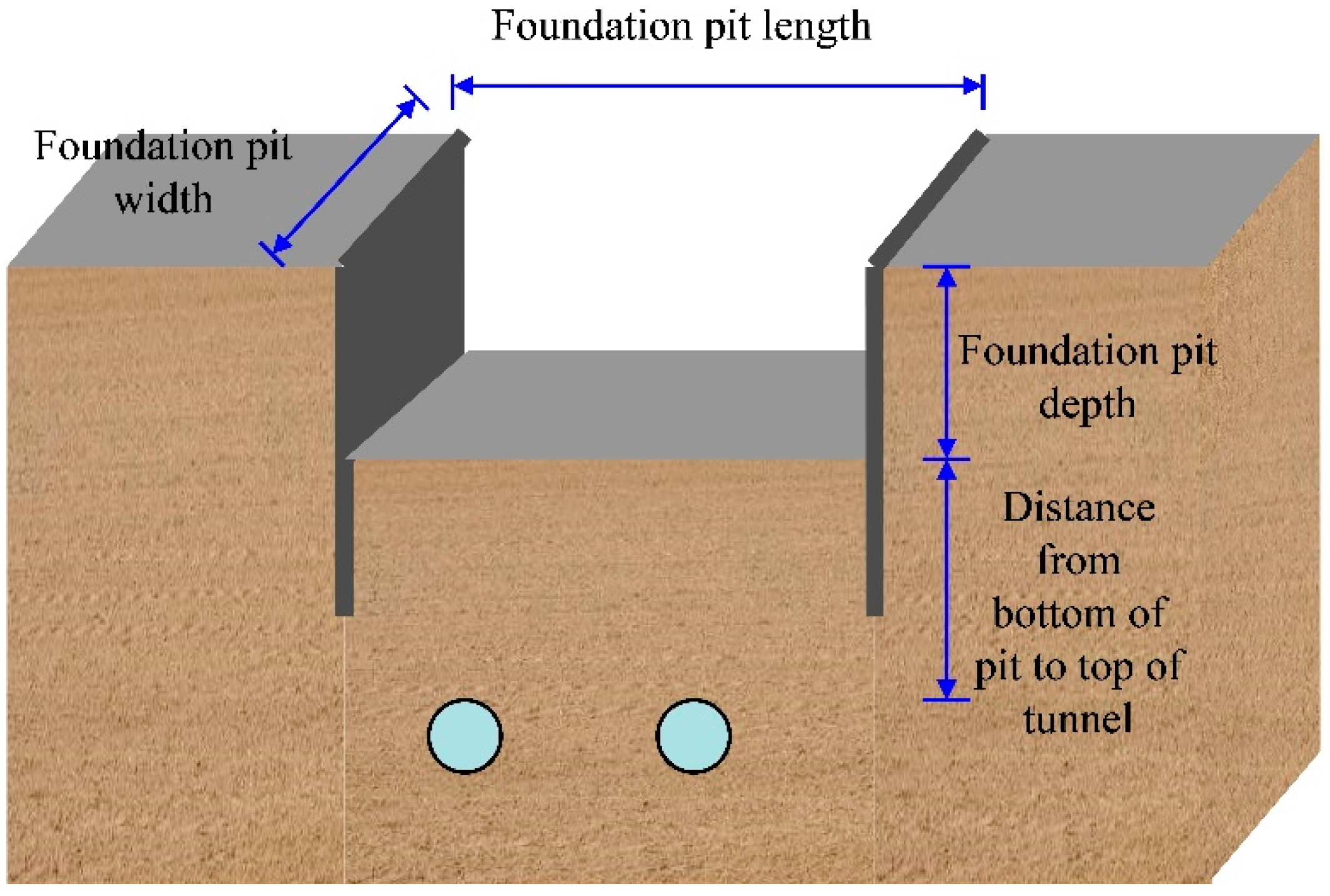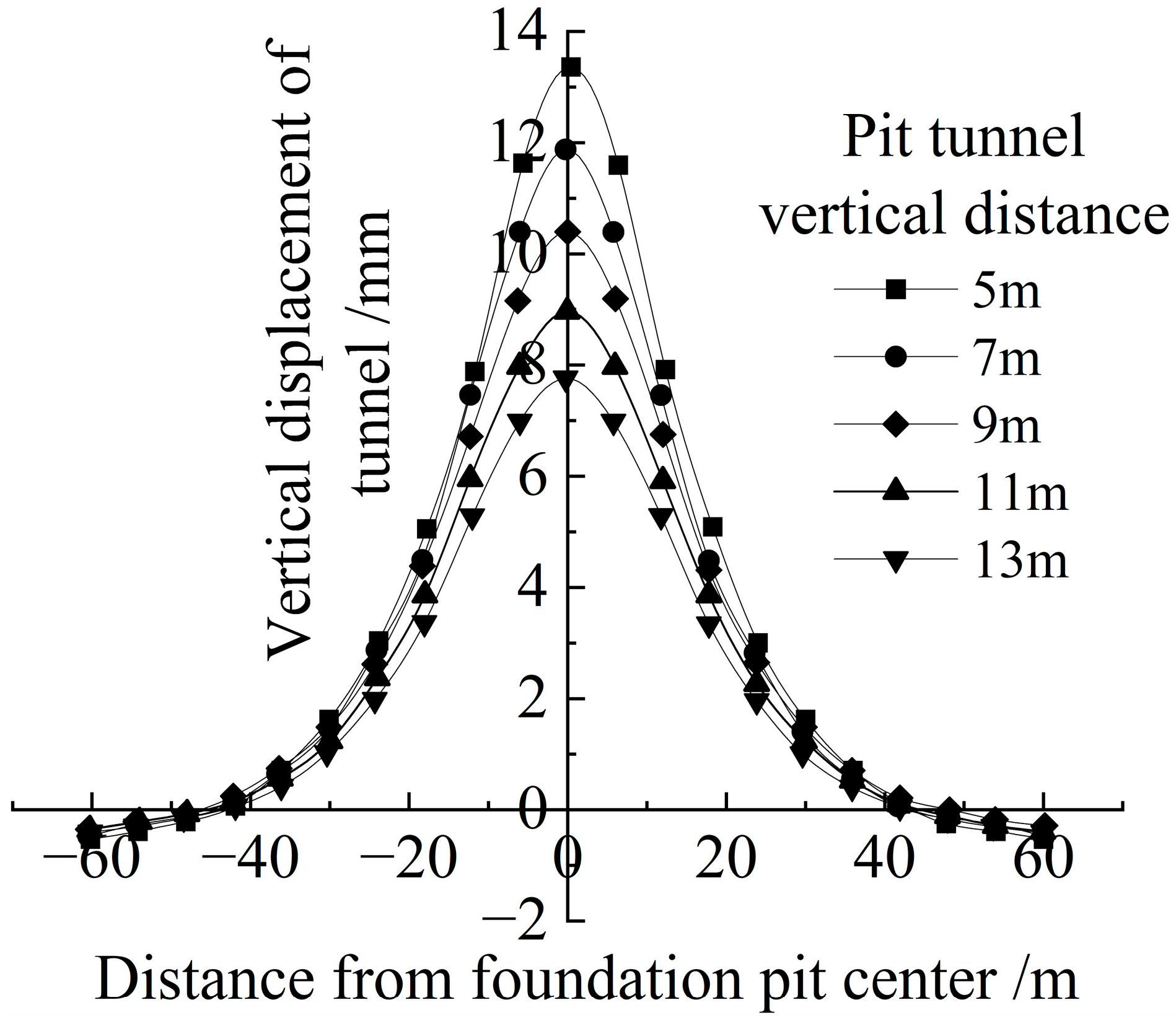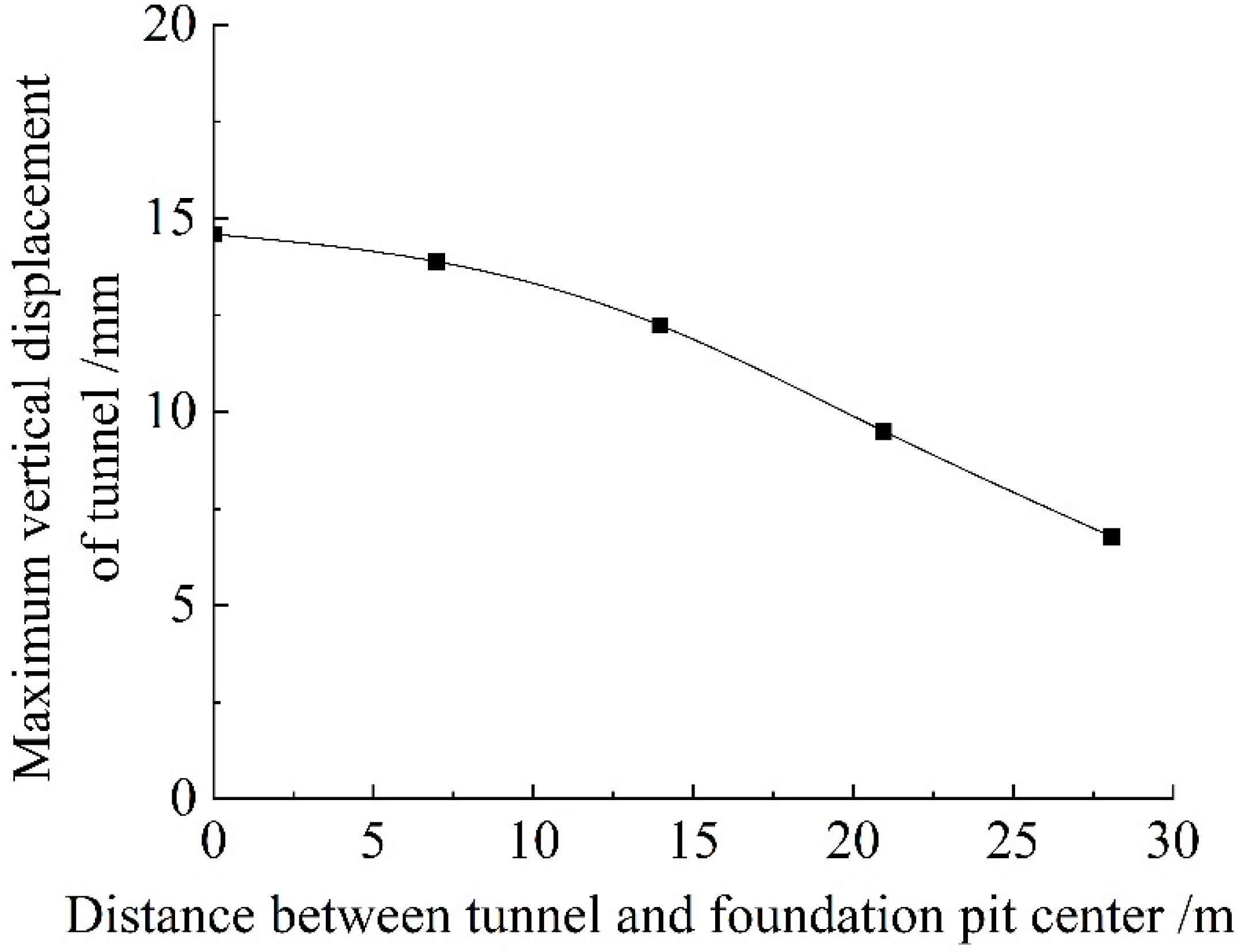Numerical Investigation of the Influence of Foundation Pit Excavation on the Deformation of Underlying Tunnels Based on a Multi-Factor Orthogonal Test
Abstract
1. Introduction
2. Numerical and Orthogonal Test Methods
2.1. Overview of the Project
2.2. Numerical Model
2.3. Contrastive Analysis of the Numerical Method and Theoretical Method
2.4. Orthogonal Test Method
3. Results and Discussion
3.1. Single-Factor Analysis
- (1)
- Effect of the Plane Shape of a Pit
- (2)
- Effect of the Pit Depth
- (3)
- Effect of Tunnel–Pit Vertical Distance
- (4)
- Effect of Tunnel–Pit Horizontal Distance
3.2. Orthogonal Test Results
4. Conclusions
Author Contributions
Funding
Data Availability Statement
Acknowledgments
Conflicts of Interest
References
- Li, Y.; Chen, J.; Huang, X.; Uan, J.-Y.; Liu, X.-W. Numerical analysis of effect of large-scale unloading on underlying shield tunnels. Chin. J. Geotech. Eng. 2013, 35, 643–646. [Google Scholar]
- Ding, J.; Chen, J.; Yu, F. Effect of foundation pit excavation on existing underlying tunnel: Case study on Chegongmiao comprehensive transportation hub on line 11 of Shenzhen metro. Tunn. Constr. 2015, 35, 867–872. [Google Scholar]
- Guo, Y.; Zhan, J.; Du, H. Influence of excavation of Zhengzhou silt foundation pit on underlying subway tunnel. J. Archit. Civ. Eng. 2019, 36, 11–20. [Google Scholar]
- Wang, L.; Xu, S.; Wang, J.; Shi, W.S.Y.; Yu, D.Q.; Qiu, J.L.; Fan, F.F. Analysis on influence of excavation of pit on existing metro tunnel in loess layer. Sci. Technol. Eng. 2022, 22, 2468–2476. [Google Scholar]
- Zhang, J.F.; Chen, J.J.; Wang, J.H.; Zhu, Y.F. Prediction of tunnel displacement induced by adjacent excavation in soft soil. Tunn. Undergr. Space Technol. 2013, 36, 24–33. [Google Scholar] [CrossRef]
- Zhang, Z.; Huang, M.; Wang, W. Evaluation of deformation response for adjacent tunnels due to soil unloading in excavation engineering. Tunn. Undergr. Space Technol. 2013, 38, 244–253. [Google Scholar] [CrossRef]
- Qiu, J.T.; Jiang, J.; Zhou, X.J.; Zhang, Y.F.; Pan, Y.D. Analytical solution for evaluating deformation response of existing metro tunnel due to excavation of adjacent foundation pit. J. Cent. South Univ. 2021, 28, 1888–1900. [Google Scholar] [CrossRef]
- Liang, R.; Wu, W.; Yu, F.; Jiang, G.; Liu, J. Simplified method for evaluating shield tunnel deformation due to adjacent excavation. Tunn. Undergr. Space Technol. 2018, 71, 94–105. [Google Scholar] [CrossRef]
- Cheng, K.; Xu, R.; Ying, H.; Liang, R.Z.; Lin, C.G.; Gan, X.L. Simplified method for evaluating deformation responses of existing tunnels due to overlying basement excavation. Chin. J. Rock Mech. Eng. 2020, 39, 637–648. [Google Scholar]
- Ou, X.; Zhang, X.; Liu, X.; Yang, J.S.; Liu, J.Q.; Han, X.F. Analytic calculation method of underlying tunnel deformation caused by excavation and dewatering of upper pit. J. Chin. Railw. Soc. 2019, 41, 153–160. [Google Scholar]
- Zheng, W. Simplified method for evaluating mechanical interactions between tunnel and soil due to adjacent excavation. Tunn. Undergr. Space Technol. 2023, 139, 105205. [Google Scholar]
- Liu, J.; Shi, C.; Lei, M.; Peng, L.; Cao, C.; Lin, Y. Analytical method for influence analysis of foundation pit excavation on underlying metro tunnel. J. Cent. South Univ. 2019, 50, 2215–2225. [Google Scholar]
- Yang, H.Q.; Zeng, Y.Y.; Lan, Y.F.; Zhou, X.P. Analysis of the excavation damaged zone around a tunnel accounting for geostress and unloading. Int. J. Rock Mech. Min. 2014, 69, 59–66. [Google Scholar] [CrossRef]
- Zhang, J. Deformation response of metro tunnel in undulant soil and rock strata affected by upper foundation pit construction. Tunn. Constr. 2019, 39, 1247–1254. [Google Scholar]
- Zhang, X.; Wei, G.; Lin, X.; Xia, C.; Wei, X. Transverse force analysis of adjacent shield tunnel caused by foundation pit excavation considering deformation of retaining structures. Symmetry 2021, 13, 1478. [Google Scholar] [CrossRef]
- Li, M.G.; Xiao, X.; Wang, J.H.; Chen, J.J. Numerical study on responses of an existing metro line to staged deep excavations. Tunn. Undergr. Space Technol. 2019, 85, 268–281. [Google Scholar] [CrossRef]
- Gao, C.; Zhang, D.; Yan, J. Risk analysis of existing shield tunnel caused by multistep unloading and re-loading of adjacent engineering activity. Eng. J. Wuhan Univ. 2016, 49, 708–713. [Google Scholar]
- Zhuang, Y.; Cui, X.; Hu, S. Numerical simulation and simplified analytical method to evaluate the displacement of adjacent tunnels caused by excavation. Tunn. Undergr. Space Technol. 2023, 132, 104879. [Google Scholar] [CrossRef]
- Huang, X.; Schweiger, H.F.; Huang, H. Influence of deep excavations on nearby existing tunnels. Int. J. Geomech. 2013, 13, 170–180. [Google Scholar] [CrossRef]
- Huang, H.; Huang, X.; Schweiger, F.H. Numerical analysis of the influence of deep excavation on underneath existing road tunnel. Chin. Civil Eng. J. 2012, 45, 182–189. [Google Scholar]
- Zhang, G.; Wei, S.W. Numerical analyses of influence of overlying pit excavation on existing tunnels. J. Cent. South Univ. Technol. 2008, 15, 69–75. [Google Scholar] [CrossRef]
- Gu, X.; Chen, F.; Zhang, W.; Wang, Q.; Liu, H. Numerical investigation of pile responses induced by adjacent tunnel excavation in spatially variable clays. Undergr. Space 2022, 7, 911–927. [Google Scholar] [CrossRef]
- He, C.; Cai, Y.; Pu, C.; Zhou, S.; Di, H.; Zhang, X. Deformation analysis and protection measures of existing metro tunnels effected by river channel excavation in soft soils. Tunn. Undergr. Space Technol. 2024, 144, 105504. [Google Scholar] [CrossRef]
- Tanoli, A.Y.; Yan, B.; Xiong, Y.L.; Ye, G.L.; Khalid, U.; Xu, Z.H. Numerical analysis on zone-divided deep excavation in soft clays using a new small strain elasto-plastic constitutive model. Undergr. Space 2022, 7, 19–36. [Google Scholar] [CrossRef]
- Zhao, X.; Li, Z.; Dai, G.; Wang, H.; Yin, Z.; Cao, S. Numerical study on the effect of large deep foundation excavation on underlying complex intersecting tunnels. Appl. Sci. 2022, 12, 4530. [Google Scholar] [CrossRef]
- Wen, K.; Liu, S.; Yang, H. Three-dimensional numerical simulation analysis of the influence of pit excavation based on hardening soil-small strain model for metro tunnel. Eng. Mech. 2018, 35, 80–87. [Google Scholar]
- Shi, J.; Ng, C.W.W.; Chen, Y. Three-dimensional numerical parametric study of the influence of basement excavation on existing tunnel. Comput. Geotech. 2015, 63, 146–158. [Google Scholar] [CrossRef]
- Wang, C.; Ling, D.; Wang, H. Influence of soft clay structure on pit excavation and adjacent tunnels. J. Zhejiang Univ. 2020, 54, 264–274. [Google Scholar]
- Zhang, D.M.; Xie, X.C.; Li, Z.L.; Zhang, J. Simplified analysis method for predicting the influence of deep excavation on existing tunnels. Comput. Geotech. 2020, 121, 103477. [Google Scholar] [CrossRef]
- Liu, B.; Shao, C.; Wang, N.; Zhang, D. Influenced zone of deep excavation and a simplified prediction method for adjacent tunnel displacement in thick soft soil. Appl. Sci. 2023, 13, 4647. [Google Scholar] [CrossRef]
- Liu, B.; Shao, C.; Xu, W. Influenced zone of deep excavation on adjacent tunnel displacement and control effect of ground improvement in soft soil. Appl. Sci. 2022, 12, 9047. [Google Scholar] [CrossRef]
- Zhao, Y.; Chen, X.; Hu, B.; Wang, P.; Li, W. Evolution of tunnel uplift induced by adjacent long and collinear excavation and an effective protective measure. Tunn. Undergr. Space Technol. 2023, 131, 104846. [Google Scholar] [CrossRef]
- Xiao, Z.; Xie, S.; Hu, A.; Chen, Y.; Wang, M. Displacement control in irregular deep excavation adjacent to tunnel groups in structural soil: A case study of MJS cement-soil composite piles and grouting rectification. Case Stud. Constr. Mat. 2024, 20, e03085. [Google Scholar] [CrossRef]
- Li, M.G.; Chen, J.J.; Wang, J.H.; Zhu, Y.F. Comparative study of construction methods for deep excavations above shield tunnels. Tunn. Undergr. Space Technol. 2018, 71, 329–339. [Google Scholar] [CrossRef]
- Xiao, X.; Li, M.G.; Wang, J.H.; Chen, J.J. Numerical evaluation of control measures for tunnel deformation induced by an oversized deep excavation. J. Aerosp. Eng. 2018, 31, 04018109. [Google Scholar] [CrossRef]
- Ye, S.; Zhao, Z.; Wang, D. Deformation analysis and safety assessment of existing metro tunnels affected by excavation of a foundation pit. Undergr. Space 2021, 6, 421–431. [Google Scholar] [CrossRef]
- Sharma, J.S.; Hefny, A.M.; Zhao, J.; Chan, C.W. Effect of large excavation on deformation of adjacent MRT tunnels. Tunn. Undergr. Space Technol. 2001, 16, 93–98. [Google Scholar] [CrossRef]
- Peng, T.; Ren, D.; Kang, C.; Liu, H.; Xue, P.; Huang, H. Deformation characteristics of soft soil induced by deep excavation and its impact on adjacent tunnels: A case study in Shanghai. KSCE J. Civ. Eng. 2024, 28, 1715–1728. [Google Scholar] [CrossRef]
- Cheng, R.; Ye, Y.; Wang, C. Influence of open-cut tunneling on uplift behaviour of underlying metro tunnel. J. Zhejiang Univ. 2017, 51, 1269–1277. [Google Scholar]
- Zhang, H.B.; Chen, J.J.; Fan, F. Wang, J.H. Deformation monitoring and performance analysis on the shield tunnel influenced by adjacent deep excavations. J. Aerosp. Eng. 2015, 30, B4015002-1. [Google Scholar] [CrossRef]
- Chen, R.; Meng, F.; Li, Z.; Ye, Y.; Ye, J. Investigation of response of metro tunnels due to adjacent large excavation and protective measures in soft soils. Tunn. Undergr. Space Technol. 2016, 58, 224–235. [Google Scholar] [CrossRef]
- Ran, L.; Ding, Y.; Chen, Q.; Zou, B.; Ye, X. Influence of adjacent shield tunneling construction on existing tunnel settlement: Field monitoring and intelligent prediction. J. Zhejiang Univ.-Sci. A 2023, 24, 1106–1119. [Google Scholar] [CrossRef]
- Li, Z.; Yang, K.; Xu, X.; Yang, Y.; Jiang, Y.; Tong, L.; Chen, Y. Investigation of metro tunnel response to multiple adjacent large excavations in soft soils. Tunn. Undergr. Space Technol. 2024, 152, 105935. [Google Scholar] [CrossRef]
- Zhao, Y.; Chen, X.; Hu, B.; Huang, L.; Lu, G.; Yao, H. Automatic monitoring and control of excavation disturbance of an ultra-deep foundation pit extremely adjacent to metro tunnels. Tunn. Undergr. Space Technol. 2023, 142, 105445. [Google Scholar] [CrossRef]
- Zhu, H.H.; Wang, D.Y.; Shi, B.; Wang, X.; Wei, G.Q. Performance monitoring of a curved shield tunnel during adjacent excavations using a fiber optic nervous sensing system. Tunn. Undergr. Space Technol. 2022, 124, 104483. [Google Scholar] [CrossRef]
- Ng, C.W.W.; Shi, J.W.; Hong, Y. Three-dimensional centrifuge modelling of basement excavation effects on an existing tunnel in dry sand. Can. Geotech. J. 2013, 50, 874–888. [Google Scholar] [CrossRef]
- Yao, A.-J.; Zhang, J.-T.; Gao, H.-F. Influence of unloading-loading of foundation on shield tunnel underneath. Rock Soil Mech. 2018, 39, 2318–2326. [Google Scholar]
- Zhang, Y.; Xie, Y.; Weng, M. Centrifugal test on influence of asymmetric foundation excavation to an underlying subway tunnel. Rock Soil Mech. 2018, 39, 2555–2562. [Google Scholar]
- Liang, R.; Wu, J.; Sun, L.; Shen, W.; Wu, W. Performances of adjacent metro structures due to zoned excavation of a large-scale basement in soft ground. Tunn. Undergr. Space Technol. 2021, 117, 104123. [Google Scholar] [CrossRef]
- Tan, Y.; Li, X.; Kang, Z.; Liu, J.; Zhu, Y. Zoned excavation of an oversized pit close to an existing metro line in stiff clay: Case study. J. Perform. Constr. Facil. 2015, 29, 04014158. [Google Scholar] [CrossRef]
- Liu, G.B.; Huang, P.; Shi, J.W.; Ng, C.W.W. Performance of a deep excavation and its effect on adjacent tunnels in Shanghai soft clay. J. Perform. Constr. Facil. 2016, 30, 04016041. [Google Scholar] [CrossRef]
- Hu, Z.F.; Yue, Z.Q.; Zhou, J.; Tham, L.G. Design and construction of a deep excavation in soft soils adjacent to the Shanghai Metro tunnels. Can. Geotech. J. 2003, 40, 933–948. [Google Scholar] [CrossRef]
- Zheng, G.; Su, Y.; Diao, Y.; Zhao, Y.; Chen, H.; Huang, J. Field measurements and analysis of real-time capsule grouting to protect existing tunnel adjacent to excavation. Tunn. Undergr. Space Technol. 2022, 122, 104350. [Google Scholar] [CrossRef]
- Yang, A. Research on Influence of Existing Tunnel Deformation Caused by Foundation Pit Excavation above Subway. Master’s Thesis, Henan University of Technology, Zhengzhou, China, 2020. [Google Scholar]
- Zhang, Y. The Deformation Effect of Existing Subway Tunnel Adjacent to Foundation Pit Excavation. Master’s Thesis, Northwest Agriculture and Forestry University, Xianyang, China, 2018. [Google Scholar]
- Zhang, Y.; Yin, Z.; Xu, Y. Analysis on three-dimensional ground surface deformations due to shield tunnel. Chin. J. Rock Mech. Eng. 2002, 21, 388–392. [Google Scholar]
- Liu, B.; Fan, X.H.; Wang, Y.Y.; Hang, J.-B.; Fan, Z.-B. Influences of excavation on adjacent existing metro tunnels: A review. Chin. J. Geotech. Eng. 2021, 43, 253–258. [Google Scholar]








| Soil Type | Unit Weight/kN∙m−3 | Elastic Modulus/MPa | Poisson’s Ratio | Cohesion /kPa | Internal Friction /° | Thickness /m |
|---|---|---|---|---|---|---|
| Miscellaneous soil | 17.8 | 25 | 0.3 | 19.6 | 24 | 1.5 |
| Silt | 19.6 | 27 | 0.31 | 20 | 24 | 17 |
| Silt clay | 19.8 | 30 | 0.3 | 22 | 31.6 | 20 |
| Fine sand | 21 | 40 | 0.3 | 0 | 35.6 | 30 |
| Influence Factor | Level 1 | Level 2 | Level 3 |
|---|---|---|---|
| Pit shape (A)/m | 20 × 45 | 30 × 30 | 45 × 20 |
| Excavation depth (B)/m | 4 | 8 | 12 |
| Pit tunnel vertical distance (C)/m | 5 | 9 | 13 |
| Pit tunnel horizontal distance (D)/m | 0 | 14 | 28 |
| Test No. | Influence Factor | Maximum Vertical Displacement of Tunnel/mm | |||
|---|---|---|---|---|---|
| Pit Shape/m | Excavation Depth/m | Pit Tunnel Vertical Distance/m | Pit Tunnel Horizontal Distance/m | ||
| 1 | 20 × 45 | 4 | 5 | 0 | 8.4 |
| 2 | 20 × 45 | 8 | 9 | 14 | 12.2 |
| 3 | 20 × 45 | 12 | 13 | 28 | 9.2 |
| 4 | 30 × 30 | 4 | 9 | 28 | 4 |
| 5 | 30 × 30 | 8 | 13 | 0 | 13.6 |
| 6 | 30 × 30 | 12 | 5 | 14 | 32.1 |
| 7 | 45 × 20 | 4 | 13 | 14 | 5.1 |
| 8 | 45 × 20 | 8 | 5 | 28 | 10.6 |
| 9 | 45 × 20 | 12 | 9 | 0 | 28.8 |
| Influence Factor | K1 | K2 | K3 | Amplitude of Variation, R | Order of Influence |
|---|---|---|---|---|---|
| Pit shape (A)/m | 9.96 | 16.59 | 14.85 | 6.63 | 4 |
| Excavation depth (B)/m | 5.85 | 12.16 | 23.4 | 17.55 | 1 |
| Pit tunnel vertical distance (C)/m | 17.06 | 15.02 | 9.33 | 7.73 | 3 |
| Pit tunnel horizontal distance (D)/m | 16.95 | 16.5 | 7.96 | 8.99 | 2 |
| Influence Factor | Degree of Dispersion, Q | Degree of Freedom, f | Influence Degree of Factors, F | Significance Level | Order of Influence |
|---|---|---|---|---|---|
| Pit shape | 70.9 | 2 | 0.36 | Non-significant | 4 |
| Excavation depth | 474.03 | 2 | 2.38 | Significant | 1 |
| Pit tunnel vertical distance | 96.4 | 2 | 0.49 | Non-significant | 3 |
| Pit tunnel horizontal distance | 153.96 | 2 | 0.77 | Non-significant | 2 |
| Error value | 74.29 | 4 | - | - |
Disclaimer/Publisher’s Note: The statements, opinions and data contained in all publications are solely those of the individual author(s) and contributor(s) and not of MDPI and/or the editor(s). MDPI and/or the editor(s) disclaim responsibility for any injury to people or property resulting from any ideas, methods, instructions or products referred to in the content. |
© 2024 by the authors. Licensee MDPI, Basel, Switzerland. This article is an open access article distributed under the terms and conditions of the Creative Commons Attribution (CC BY) license (https://creativecommons.org/licenses/by/4.0/).
Share and Cite
Wang, Q.; Jiang, M.; Feng, D.; Lu, H.; Yao, M.; Yang, A.; Cao, M.; Ma, Z. Numerical Investigation of the Influence of Foundation Pit Excavation on the Deformation of Underlying Tunnels Based on a Multi-Factor Orthogonal Test. Buildings 2024, 14, 2618. https://doi.org/10.3390/buildings14092618
Wang Q, Jiang M, Feng D, Lu H, Yao M, Yang A, Cao M, Ma Z. Numerical Investigation of the Influence of Foundation Pit Excavation on the Deformation of Underlying Tunnels Based on a Multi-Factor Orthogonal Test. Buildings. 2024; 14(9):2618. https://doi.org/10.3390/buildings14092618
Chicago/Turabian StyleWang, Qingshan, Minmin Jiang, Dakuo Feng, Hailu Lu, Mengcheng Yao, Anlun Yang, Meng Cao, and Zhongyang Ma. 2024. "Numerical Investigation of the Influence of Foundation Pit Excavation on the Deformation of Underlying Tunnels Based on a Multi-Factor Orthogonal Test" Buildings 14, no. 9: 2618. https://doi.org/10.3390/buildings14092618
APA StyleWang, Q., Jiang, M., Feng, D., Lu, H., Yao, M., Yang, A., Cao, M., & Ma, Z. (2024). Numerical Investigation of the Influence of Foundation Pit Excavation on the Deformation of Underlying Tunnels Based on a Multi-Factor Orthogonal Test. Buildings, 14(9), 2618. https://doi.org/10.3390/buildings14092618






